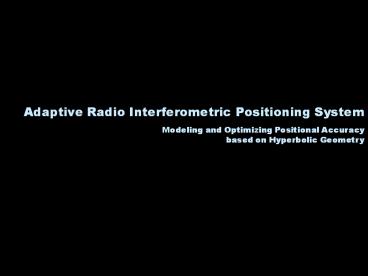Adaptive Radio Interferometric Positioning System PowerPoint PPT Presentation
Title: Adaptive Radio Interferometric Positioning System
1
Adaptive Radio Interferometric Positioning System
Modeling and Optimizing Positional Accuracy based
on Hyperbolic Geometry
2
Motivation
- Location is an important information in many
sensor network application - Example
- Environment monitor
3
Radio Interferometric Positioning (RIP) System
- Proposed by Vanderbilt University
- High accuracy
- Error lt 1m
- Long sensing range
- Few nodes can cover wide area
- Low cost
- Using standard sensor network devices (Mica2), no
additional specialized hardware
4
Original RIP system
- Anchor nodes are placed in known locations
- The positional error of RIP system is highly
affected by target locations and the selection of
beacon nodes - Original RIP system is static
- The selection of beacon nodes is fixed, doesnt
change depend on target locations
Beacon
T
Beacon
5
Our Contribution
- Design, implement and evaluate an adaptive RIP
system - Dynamically select beacon nodes based on target
locations
6
Flow of RIP system
Ranging
Positioning
- Two ranging rounds
- In each ranging round, we need select beacon
nodes - Two nodes are selected as senders (sender-pair)
- Other nodes become receivers
Anchor node (known location)
7
RIP ranging
- Ranging_result
- distance(T,sender1) distance(T,sender2)
- d1 d2
- Each ranging result in a
- hyperbolic curve
- Two ranging needed for positioning
- Sender-pairs selected in two
- ranging round are called
- Sender Pair Combination (SPC)
sender1
sender2
sender1
d1
d1
d2
T
d2
sender2
8
Flow of RIP system
Ranging
Positioning
Errorrange
Errorpositional
- Uncontrollable
- Can approximate from historical location
- Target location
- Selection of SPC
- Controllable
9
How SPC selection affect positional error
- Ranging with error gt Hyperbolic curve with error
gt Positioning with error
sender1
sender2
sender1
sender1
sender2
Errorrange
T
T
T
T
sender2
sender1
sender2
10
How SPC selection affect positional error (cont.)
- Displacement of a hyperbolic curve
- Shortest distance from hyperbolic curve with
error to target
sender1
sender2
Errorrange
T
T
sender1
sender2
11
How SPC selection affect positional error (cont.)
- Intersectional angle of hyperbolic curves
T
T
T
?
?
?
T
T
T
? 90
? 60
? 30
12
How SPC selection affect positional error (cont.)
- Intersectional angle of hyperbolic curves
sender1
sender2
sender1
sender1
sender2
Errorrange
?
?
T
T
T
T
sender2
sender1
sender2
13
Adaptive RIP system
- Given changing target locations ( from historical
data ), select optimal SPC with minimal
Errorpositional - Estimation Error Model
- Predict Errorpositional using specific SPC
- We run Estimation Error Model for all SPC, and
find the SPC with minimum error
14
Estimation Error Model
- Known Variables
- Target location
- SPC
- Errorrange
- Unknown
- Errorpositional
15
Geometrical Derivation of Estimation Error Model
- PT is the estimation Errorpositional
- N is the projection point of T on H12
- TN is the displacement of hyperbolic curves H12
- ? is the intersectional angle of hyperbolic
curves H12 and H34 - Find TM (TN) and ? geometrically
- Find PT geometrically
Errorrange
16
Validation of Estimation Error Model
17
Adaptive RIP system
- Given changing target locations ( from historical
data ), select optimal SPC with minimal
Errorpositional - For multi-target positioning, select optimal SPC
with minimal average Errorpositional for all
targets
18
System architecture
SPC, Target positions
SPC1
Estimation Error Model
SPC selector
SPC2
Estimation Error of SPC1
Estimation Error of T1
Optimal SPC
Estimation Error of T2
Estimation Error of SPC2
Estimation Error of T3
Estimation Error of SPC3
Estimation Errorpositional
Estimation Error of T4
Adaptive SPC
Estimation Error of T5
RIP engine
Target position
Target positions
19
Evaluation of adaptive RIP system
- Single-target positioning experiment
- Multi-target positioning experiment
AF are anchor nodes
Each grid is 1m2
20
Single-target positioning experiment
Adaptive RIP
Static RIP
Blue line target path Blue point ground
truth Red point estimation position
21
Single-target positioning experiment
Average error (meter) 90-th percentile (meter)
Static RIP 0.93 1.66
Adaptive RIP 0.49 0.75
Improvement 47 55
walking repeatedly 5 times, around 50 samples
22
Multi-target positioning experiment
- 6 targets
- 1 moving (blue point)
- 5 static (15 green points)
23
Multi-target positioning experiment
Static
Average error (meter) 90-th percentile (meter)
Static RIP 0.75 1.41
Adaptive RIP 0.30 0.54
Improvement 60 61
24
Conclusion
- Since the Errorpositional of RIP system is
impacted by target location and SPC selection, an
adaptive RIP system is needed - Build upon Estimation Error Model, our adaptive
RIP system can dynamically find optimal SPC with
minimal Errorpositional based on target location - Our adaptive RIP system outperforms static RIP
system in both single-target and multi-target
positioning
25
Q A
26
Thank you
27
Flow of RIP system
Sender1
Receiver1
Receiver1
Ranging
Positioning
Sender1
2nd ranging
1st ranging
T
- Start RIP system
- Select 2 anchor nodes as senders
- Other anchor nodes become receiver
- Ranging
- If 1st ranging gt goto 2 and do 2nd ranging
- else gt goto 6 do positioning
- Positioning
- End
Sender2
Receiver2
Receiver2
Sender2
Anchor node (known location)
28
Geometrical Derivation of Estimation Error Model
- Steps
- Find TN (TM)
- Find ?
- Find PT geometrically
mN
- Known Variables
- Target location
- SPC
- Errorrange
mM
If we know TN, TM, ?, we can derivative PT
geometrically

